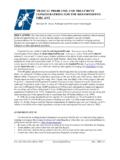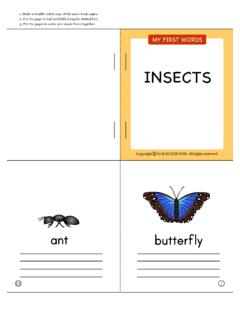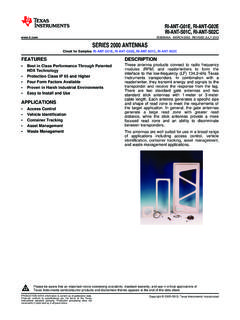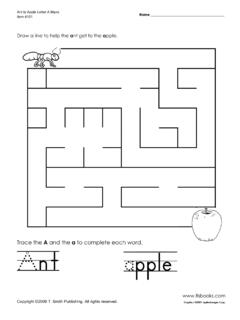Transcription of Diversity and Distributions, (Diversity Distrib ...
1 2005 Blackwell Publishing Ltd : 319 Diversity and Distributions, ( Diversity Distrib .) (2005) 11 , 319 331 BIODIVERSITYRESEARCH ABSTRACT Analysis of long-term patterns of invasion can reveal the importance of abiotic factorsin influencing invasion dynamics, and can help predict future patterns of spread. Inthe case of the invasive Argentine ant ( Linepithema humile ), most prior studies haveinvestigated this species limitations in hot and dry climates. However, spatial andtemporal patterns of spread involving two ant populations over the course of 30 yearsat a high elevation site in Hawaii suggest that cold and wet conditions have influencedboth the ant s distribution and its rate of invasion.
2 In Haleakala National Park onMaui, we found that a population invading at lower elevation is limited by increasingrainfall and presumably by associated decreasing temperatures. A second, higher eleva-tion population has spread outward in all directions, but rates of spread in differentdirections appear to have been strongly influenced by differences in elevation andtemperature. Patterns of foraging activity were strongly tied to soil temperatures,supporting the hypothesis that variation in temperature can influence rates of on past patterns of spread, we predicted a total potential range that coversnearly 50% of the park and 75% of the park s subalpine habitats. We compared thisrough estimate with point predictions derived from a degree-day model for Argentineant colony reproduction, and found that the two independent predictions matchclosely when soil temperatures are used in the model.
3 The cold, wet conditions thathave influenced Argentine ant invasion at this site are likely to be influential at otherlocations in this species current and future worldwide distribution. Keywords Biological invasions, invasive species, Linepithema humile , range limits, rate of spread. INTRODUCTION A central goal of invasion biology is predicting where a givenspecies will invade, and in which directions it will spread onceestablished. Understanding how biotic and abiotic factors influ-ence invasion dynamics is integral to this endeavour. Recentwork on invasive ants suggests that invasion success in this groupis in some situations governed more by abiotic suitability than bybiotic resistance, particularly with respect to resistance from thenative biota.
4 Although Way et al . (1997) provide evidence thatsome native ant species can limit the highly invasive Argentineant ( Linepithema humile [Mayr]) in Portugal, and Majer (1994)hypothesized that native ants might prevent invasion of theArgentine ant in some areas of Western Australia, in many otherlocations around the world, a handful of invasive ant species havealmost entirely displaced native ant assemblages (Holway et al .,2002a). These few invasive ant species appear to share severalbiological traits that confer substantial competitive advantages(Holway et al ., 2002a), and as a result, resistance from nativeants, which are probably their most significant competitors,appears to be less important than environmental conditions indetermining where they will invade.
5 In southern California, forinstance, Holway et al . (2002b) demonstrated that soil moistureand temperature are critical factors influencing invasion successfor the Argentine ant, irrespective of native ant of the abiotic tolerances of invasive ant species invarious climates and habitat types should therefore contributesignificantly to our ability to predict future invasion. In Hawaii,the Argentine ant occurs on several islands at elevations rangingfrom approximately 950 to 2850 m Hawaii has no native antspecies (Wilson & Taylor, 1967), and at higher elevations, theArgentine ant often faces no competition from other dominantinvasive ant species. It also appears to be free from natural enem-ies, and provided that food resources are not limiting, abioticconditions should usually be the only factors governing itsspread.
6 In Haleakala National Park (NP) on Maui, two large and 1 USGS Pacific Island Ecosystems Research Center, Haleakala Field Station, PO Box 369, Makawao, HI 96768, USA; 2 Department of Botany, University of Hawaii at Manoa, 3190 Maile Way, Honolulu, HI 96822, USA *Correspondence: Paul D. Krushelnycky, Department of Environmental Science, Policy and Management, University of California, 137 Mulford Hall #3114, Berkeley, CA 94720, USA. E-mail: Present address: Department of Botany, University of Hawaii at Manoa, 3190 Maile Way, Honolulu, HI 96822, USA Blackwell Publishing, Ltd. The role of abiotic conditions in shaping the long-term patterns of a high-elevation Argentine ant invasion Paul D. Krushelnycky 1 *, Stephanie M.
7 Joe 1 , Arthur C. Medeiros 1 , Curtis C. Daehler 2 and Lloyd L. Loope 1 P. D. Krushelnycky et al . 320 Diversity and Distributions , 11 , 319 331, 2005 Blackwell Publishing Ltd geographically separate unicolonial populations of the Argentineant are invading the upper portions of Haleakala volcano. Firstrecorded in 1967, Argentine ants now occupy over 500 ha in thepark and adjacent ranchland. The record of Argentine ant invasionat Haleakala National Park is unusual because of its long durationand fine resolution, and represents an excellent opportunity toassess the influence of abiotic variables on the spread of animportant invasive species. Ongoing spread at this site is ofutmost concern because a number of native Hawaiian arthropodgroups, many with member taxa endemic to upper Haleakalavolcano, are highly vulnerable to Argentine ant predation orcompetition (Cole et al.)
8 , 1992).We analysed the spatial and temporal patterns of spread of thetwo ant populations in Haleakala NP from 1967 to 1997. We usedavailable geographical and climate data, and collected additionaldata regarding the effects of temperature on foraging activity, toassess the roles of these abiotic variables in governing where andhow quickly the ant has been invading. Next, we used these findingsto predict the total potential range for the Argentine ant in thepark, and to estimate how long it would take for L. humile tooccupy this range. Finally, we compared our predictions againstcalculations derived from a recently developed degree-day modelfor Argentine ant reproduction and colony growth (Hartley &Lester, 2003).
9 METHODSS tudy site and organism Like other highly invasive ant species, the Argentine ant has aunicolonial social structure, forming large, continuous colonieswith interconnected nests that exhibit little or no aggressiontowards one another (H lldobler & Wilson, 1990). Queens of L. humile , unlike those of most ant species, are not known toparticipate in nuptial flights (Markin, 1970b; Benois, 1973;Passera et al ., 1988). Dispersal therefore proceeds via two mech-anisms: long distance jump dispersal, and contiguous expansionthrough budding (Erickson, 1971; Holway, 1995; Suarez et al .,2001). Most of the spread in Haleakala NP has involved budding,but a human-mediated jump dispersal event was almost cer-tainly responsible for initiating a second, higher elevationinvasion by introducing propagules from the first.
10 Such unico-lonial entities have been referred to as populations (H lldobler& Wilson, 1990; Krushelnycky & Reimer, 1998; Giraud et al .,2002), indicating groups of nests rather than groups of colonies,or supercolonies ( H lldobler & Wilson, 1990; Holway et al ., 1998; Krushelnycky et al ., 2004). Because the latter termhas also been used to denote non-aggression among nestsseparated by large distances and even intervening uninvadedhabitat (Holway et al ., 1998; Tsutsui et al ., 2000; Giraud et al .,2002), we feel that our original usage of populations is moreappropriate for the situation at Haleakala. Throughout this paperwe refer to the older contiguous invasion at 1900 2375 m elevationencompassing park headquarters as the lower population, andthe spatially separate younger invasion encompassing Kalahakuoverlook at 2725 2850 m elevation and extending down towards2200 m elevation within the Haleakala crater as the upper popu-lation (Figs 1 3).











